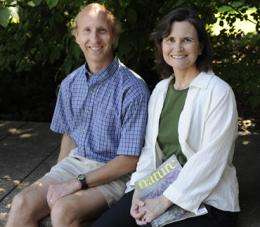ISU faculty members analyze human impact of discovery published in Nature

(PhysOrg.com) -- Two Iowa State University faculty members were invited by the journal Nature to comment on breakthrough research that may ultimately lead to new treatments for cancer patients.
Jo Anne Powell-Coffman and Clark Coffman, faculty members in the Department of Genetics, Development and Cell Biology, highlighted discoveries that were published in a recent issue of the journal Nature.
"It is an honor being asked to write for Nature," said Coffman. "It was a great opportunity."
The research in the journal describes a previously unknown mechanism by which sensory cells respond to a lack of oxygen by sending protective signals to other tissues within the organism. This enables the receiving cells to survive the potential damage caused by radiation.
In humans, cancer cells often experience low oxygen levels. This is linked to resistance to current radiation and chemotherapy treatments of some cancers.
Nature approached Powell-Coffman about analyzing the new research because of her expertise in the area of cellular responses to the stresses caused by low oxygen.
"In 2001, our group published a paper that helped to establish C. elegans (a small, soil-dwelling worm) as a system to study how animals respond to low oxygen. Since then, we and others have used an array of genetic approaches to study oxygen-sensing machinery in this simple organism. This has led to important insights about how human tissues respond to insufficient oxygen," she said.
"We've published and often review papers on this subject. And then Nature said, 'Given your scholarship in this area, we would like you to comment on this groundbreaking research which shows a link between oxygen sensing and programmed cell death.'"
To better evaluate the full impact of the work, Powell-Coffman sought out a co-author with expertise in the field of cell death -- her husband of 18 years and ISU assistant professor, Clark Coffman.
While Coffman and Powell-Coffman have overlapping research interests, they had not collaborated on any formal research projects until a year ago, when they were awarded a grant from the ISU Center for Integrated Animal Genomics.
"In our collaborative work, we are exploring connections between low oxygen and the development of germ cells (cells that give rise to eggs and sperm). When Nature invited a review in this area of research, it made sense for the two of us to work on it together," said Powell-Coffman.
The recent findings published in Nature have clear implications for the development of new cancer therapies, according to the researchers.
"What we didn't know is that sensory cells could respond to oxygen deprivation by signaling over long distances to protect other cells from death," said Powell-Coffman.
The article shows that oxygen-sensing cells (neurons in the head) signal over long distances using a molecule that is a close cousin of the TRP2 protein in humans. This TRP2-like molecule in the worm enables cells to become resistant to radiation-induced cell death.
In humans, TRP2-expressing cells are often resistant to radiation and chemotherapies. If the pathways in humans and worms behave similarly when stressed by low oxygen, this would go a long way in explaining how some human cancers can protect themselves from current treatments, according to Coffman.
In the future, this may allow the development of treatments that can kill cancer cells despite the ability to protect themselves, he added.
"This was the new thing. And the fact that the signal that has been identified and is very similar to signals that are known to be protective of human cancers -- that's huge," said Powell-Coffman. "Because that immediately suggests that this observation could be telling us about human cancers, and why some are more curable than others."
Using this new information, medical experts may be able to take a biopsy of a cancer and see if it is a type that expresses high levels of TRP2. If it does, that may dictate which treatments may work and which may not.
"Cancer comes in a lot of different flavors," said Coffman. "They (doctors) could check and see if the cancer has high levels of TRP2. If it does, then radiation or conventional therapies are likely to be ineffective. Alternative strategies would be required."














